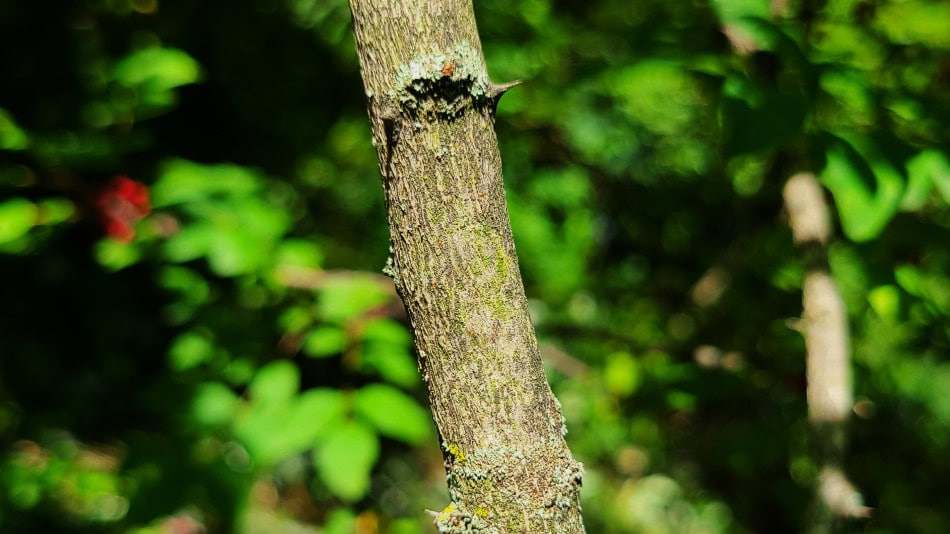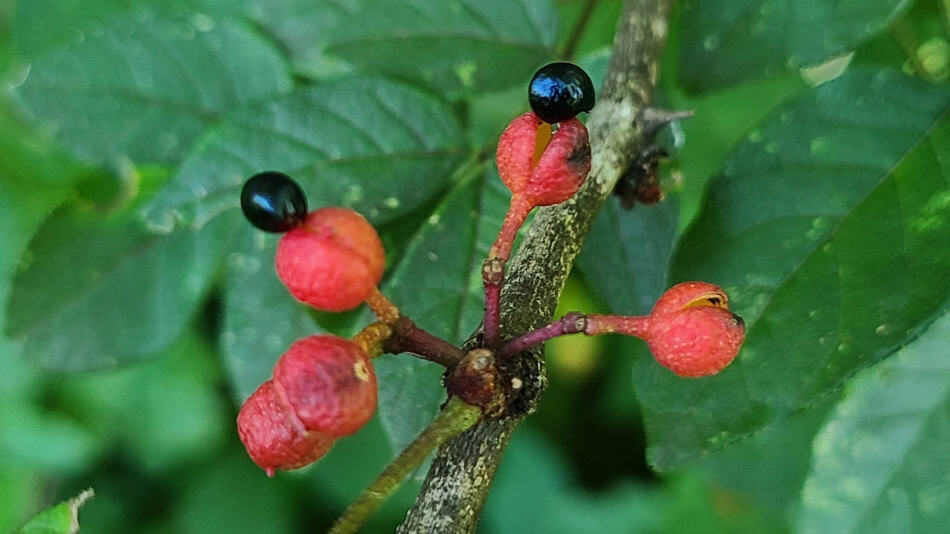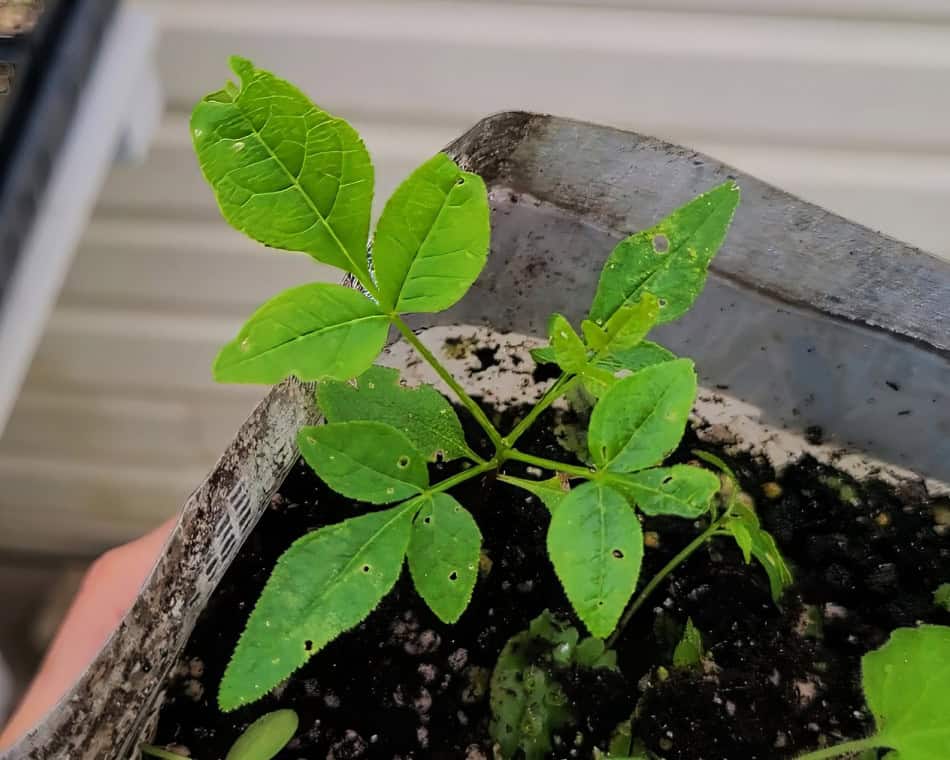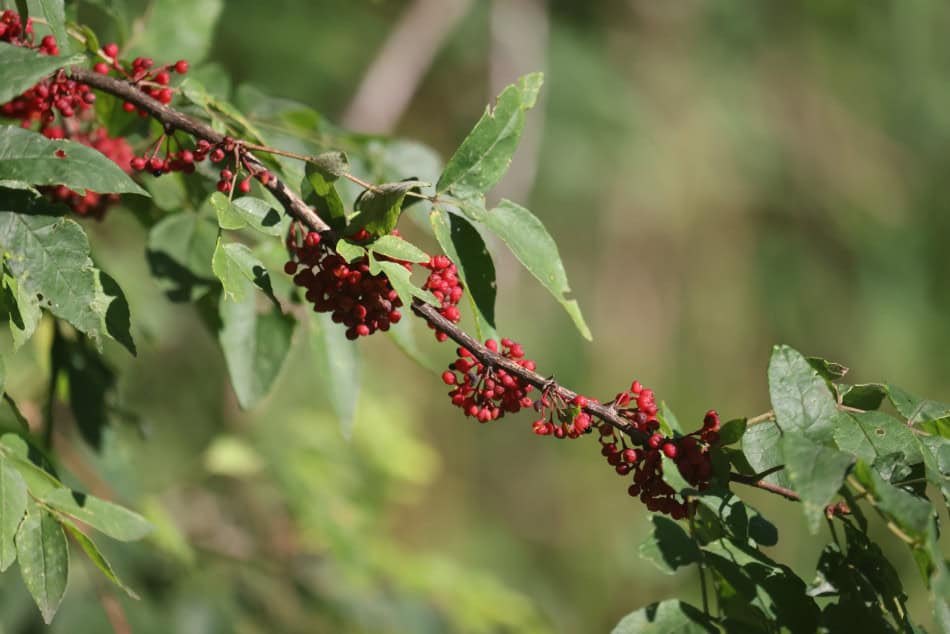One native shrub that doesn’t receive much positive attention is known as Prickly Ash. It can be easy to see how it gets it’s common name if you’ve ever tried to walk too close to one, as it is full of small thorns that do hurt and hook your clothes. Are you familiar with the saying ‘try to find the good in people’? Well, this article will hopefully show you the good in this plant, because there is much to admire or enjoy (once you get over it’s thorns and rhizomes).

Prickly Ash can effect many of our senses. If we grab it we are likely to feel pain from it’s thorns, but if we strip some leaves, berries or bark we can enjoy one of the most pleasant aromas of any plant. In early Spring we can see it’s flowers & how they feed so many pollinators, and in late Summer we can begin watching birds eat the berries. And if we give it a careful inspection, we might see some caterpillars feasting on it’s leaves as it is a host plant.

But this shrub has some uses that should make it attractive to the right person. First, it has been used medicinally by Native American Tribes for centuries for pain relief & other uses. And from a landscaping perspective, it has a suckering nature can turn it into one of the best privacy hedges that nobody would want to cross. But aside from that, it provides a lot of value to the ecosystem in that it’s flowers are an importance source of food for pollinators in early Spring, it’s berries feed numerous birds in late summer, and it hosts at least six species of moth.

I first encountered this plant at my parent’s farm (where it is prolific), and since then I’ve started working to grow it in the forest behind my house, as I believe it will be able to compete with some of the invasive species back there such as Bush Honeysuckle and Japanese Stiltgrass. But I’ll teach you all the info I can regarding
What is Prickly Ash
Prickly Ash is a relatively short lived (<40 years[1])deciduous shrub or small tree native to North America[2][3]. Scientifically known as Zanthoxylum americanum, it grows 6-30′ tall in full sun and well-draining soil[4]. It produces inconspicuous yellow/green flowers in Spring that turn into red berries that are eaten by birds in late Summer into Winter. The foliage, bark, and leaves are very aromatic and used medicinally by herbalists around the world[3].

Of all the fragrant native plants, one of the most underrated must be Prickly Ash. The aroma from the leaves and fruit is rich and makes an excellent potpourri. I first discovered this when I was carefully gathering berries to make my first attempt at growing this plant from seed. I gathered a large number of berries, and there were also a significant amount of leaves in the bag. I left this bag in the fridge for a couple weeks before extracting the seeds and my word! What an amazing smell! If you find this plant in the wild, even stripping a handful of leaves and rubbing them in your hands will give you that pleasant fragrance. Now I can’t walk past a specimen without tearing off some leaves to enjoy it, a habit that I also employ when encountering the pleasantly smelling Spicebush!
Native Range of Prickly Ash
The native range of Prickly Ash is primarily the American Midwest and Northeast, also into Southern Ontario and Quebec. It does have some strange isolated pockets in the south.

Reference Table
| Scientific Name | Zanthoxylum americanum |
| Common Name(s) | Prickly Ash, Northern Prickly Ash, Toothache Tree |
| Native Range, USDA Zone | Central and Eastern United States, USDA Zones 3-7 |
| Bloom Time | Spring |
| Bloom Duration, Color | 2-4 weeks, green/yellow, inconspicuous |
| Height | 5′-25′ |
| Spacing / Spread | 10-15′ |
| Light Requirements | Full sun to part-shade |
| Soil Types | Sandy loam, silt, clay |
| Moisture | Moist to dry, well-drained |
| Fauna Associations / Larval Hosts | Numerous bees /butterflies/moths / pollinating flies. / Hosts six species of caterpillar |
Pros and Cons
Prickly Ash does have some major benefits, but also a few drawbacks. I will briefly summarize them in this section.
Pro
Fragrant
The leaves and berries of this plant have a rich, spicy aroma. It really smells wonderful when crushed or used as potpourri.
Wildlife
This plant benefits wildlife in several ways. First, it’s flowers provide food for pollinators. Second, it’s foliage hosts several species of moth/butterfly. And third, the berries are an important food source to various songbirds.
Medicinal
This plant has been used medicinally for centuries by Native American tribes. The inner bark was frequently used to treat toothaches, or infusions made for pain / heart relief, and even for various venereal diseases.
Con
Thorny
This tree has thorns! That is mostly a drawback, as they hurt if you touch them.
Aggressive
The underground rhizomes that this plant produces will allow it to spread prolifically. So, be aware of this fact before planting!
Identification and Characteristics

Trunk / Bark
The trunk of Prickly Ash will have frequent branching, or be multi-trunked, often in a wild manner. In the open the crown will take on a obovoid shape. For bark, it is relatively smooth on most branches but can become furrowed on larger diameter, older trunks. Young shoots will have green bark. All branches, trunks, and new shoots will have small thorns or prickles that are about 1/4-3/8″ long[1][3].


Leaf
Pinnately compound leaves with an alternate arrangement occur along the trunks, the overall compounds are up to 12″ long with 5-11 leaflets. Individual leaflets are ovate to lanceolate in shape, 1-3″ long by about one-third to half as wide[1][5]. Margins can be smooth to slightly crenulate. The leaves are downy when emerging in mid-Spring (as flowers are fading).

Flower
Prickly Ash will produce both male and female flowers (dioecious) on the same tree. Clusters of peduncled 1/4″ diameter flowers occur at axillaries. Male flowers will produce 4-5 stamens while female flowers will generally have 2-5 pistils[1][5]. The overall flower color is generally yellow, or with a hint of orange. On female flowers, the ovaries will be shiny and dark green relative to the petals.

Fruit
Approximately two to three months after flowering, fruit will form where the female flowers were located. They will be in clusters, just like the flowers. They begin as green, changing to red and eventually brown as winter approaches.

Root
The root system of Prickly Ash is shallow/fibrous[1] and produces underground rhizomes, somewhat similar to Black Locust. This plant will spread and can form a thicket. And as you may suspect, you can dig up and transplant these suckers to new locations in early Spring. Or, if you just want to control them, repeated mowings will keep them down,.
Growing Conditions
Prickly Ash does well in full sun to part shade, moist to dry conditions (once established), and soil that drains well. It is very adaptable and grows quickly (24-36″ per year in full sun)[1][3]. I’ve seen this shrub mostly thriving on the edge or within open woods, and near water sources.
Maintenance
The only maintenance that will be needed on this plant is infrequent pruning in late winter as you desire, and to remove any unwanted volunteers that sprout from it’s extensive root system.
How to save seed
About 2-3 months after flowering, female flowers will develop fruits that contain a single seed. Inspect the fruit to see if it is splitting open – if it is, the seeds are ripe.

You can carefully remove the fruit from the tree and place into a container (watch out for thorns). Now, if you don’t want to process the fruit right away you can store it in the fridge for a few weeks (I waited about a month).

But squeeze the berries to extract the seed, or just allow the fruit to dry on a plate as it will split open and discard the seed. Dry the seeds from surface moisture, and then plan on using them for winter sowing that fall. No long-term storage has been studied for these seeds[6], but a small study tested seeds after 25 months of cold storage in a sealed container and had no loss of viability. Still though, the USDA recommends using fresh seed gathered in the same year.

How to Grow Prickly Ash from Seed
Pre-treatment
Since Prickly Ash is not a common nursery plant (to say the least), nobody has done extensive research on the best germination protocols. There are several sources suggesting slightly different methods, but all agreeing on one common point – the seed should undergo four months of cold-moist stratification[2][6][7]. This can be done via winter sowing (my preferred method, and what I show in pics below), or via a sealed container in moist sand in the fridge (see guide here).
But I will relay the other two treatment methods I alluded to above. Donald Leopold suggests mechanical scarification might improve the germination rates in his book Native Plants of The Northeast[2]. While Dr. Franklin Bonner of the USDA suggests scarifying via concentrated sulphuric acid for two hours [6].
Germination protocol I did
So, what did I do? I will relay it below.
Since the fruits of Prickly Ash ripen in August (zone 5), and will likely be eaten by birds, I was curious if they may need some warm stratification, since they would likely be consumed and planted naturally via birds in warm temperatures. Hence, I planted seed that was harvested four weeks prior & stored in the fridge in early September 2024. I planted it about 1/8-1/4″ deep in moist potting soil, winter sowing via milk jug. I placed this container in the shade to avoid any sunlight, as I wanted the warm September temperatures to provide a bit of warm stratification before winter set in. Also note that due to the warm temperatures, I actually watered the jug a few times before November.

In early Spring I would begin checking the jug, like all of my winter sowing adventures, and while I had many species popping up, I had no action on the Prickly Ash. But, I kept monitoring as through experience I’ve learned that some seeds just take a long time to germinate. And lo and behold on June 17 (very, very late by my standards) I had seven seedlings of Prickly Ash in the jug out of 30 seeds planted.

So I decided that since I didn’t need many plants to achieve my goal (getting some competition for invasives, and this one should be prolific), I could just separate seedlings and transfer to large pots for now, as I plan to plant these next Spring. But based on inspection of the jug, 5 of the 7 seedlings were very new, so I wonder if I had given this jug another week or two I would have had another 5-10 seedlings.

Germination rate
So how well did my method perform? Well there isn’t much to compare it to. But I had 7/30 seeds germinate for a germination rate of 23%. The only baseline I can compare it to was Dr. Bonner of the the University of Mississippi who did a cold-stratification of 120 days in sand, and achieved a 20% germination rate in 20 days of 24hr light, alternating between 20-30 degrees C[6].
Wildlife, Pests, and Diseases associated with Prickly Ash
Pollinators
Nearly sixty species of pollinator have been observed visiting Prickly Ash, mostly on the pistillate flowers. But these include short and long-tongue bees, pollinating flies and butterflies[8].
In addition to being an early pollen source for bees and wasps, Pickly Ash is also a host plant. Six different species of mothand butterfly are hosted on the leaves – Agonopterix nigrinotella, Dichomeris citrifoliella, Hyphantria cunae, Papilio cresphontes, Papilio glaucus glaucus, Papilio troilus[9]. Furthermore there are various wood-boring beetles that will destructively feed on the trunk/branches[10].
Mammals/birds
Numerous birds will eat the seeds/fruit such as Bobwhite Quail, Vieros, and pheasants. Some small rodents and rabbits will also eat the fruit[3].
Deer, Rabbits
Outside of rabbits eating the fruit, deer and rabbits will avoid this plant. The strong flavor of the leaves and twigs make this a truly deer/rabbit resistant shrub.
Where you can buy Prickly Ash
Prickly Ash is not sold in regular nurseries, as it isn’t a typical ‘garden friendly’ plant. But it could possibly be purchased at specialty nurseries that deal in Native Plants. You can find native plant nurseries near you on our interactive map. Realistically though, you may find some sources for seeds on Etsy. If not, then you will need to locate the plant and harvest the seeds yourself (with permission of course).
Uses of Prickly Ash
Landscaping
For general landscaping, this plant can be used as a hedge[2], but that is about it. It isn’t over showy, except perhaps when the ripe red berries are shown. And the foliage looks fine, but is isn’t a ‘wow’ plant by any means.

And due to it’s aggressive nature, most people would not want this plant growing in their front yard as there would be numerous ‘volunteers’ popping up. Now I plan to use that aggressive nature to my advantage to suppress Bush Honeysuckle and Japanese Stiltgrass, knowing that I will have a thorny native in it’s place, that has numerous benefits to the local ecosystem. So, it is kind of a situation where pick the lesser of two evils….When I moved into my home, it wasn’t possible to traverse the forest immediately behind my house because the Bush Honeysuckle was so thick.
Medicinal Uses
Due to it’s long history of being used by Native Americans, much research has been done to study the possible medicinal effects of this plant. It has been shown that it possesses anti-fungal properties[11], and has some chemicals that can reduce pain[12]. An older study also found that it could kill cancer cells[13], but this has not been replicated. From what I can find, as of now it is not used in medicines, but is sold by herbalists.
Native American uses
There are over sixty uses of this plant by 10 different tribes[14]. Uses ranged from infusions taken for Arthritis, back pain, kidney issues to using the bark as a wash for itching skin or other dermatology uses. But one of the more common ones gave it one of it’s common names, the toothache tree as some Tribes used the inner bark to relieve toothaches[3].
Final Thoughts
Prickly Ash is a native shrub/tree that just doesn’t get much love in the landscaping or native plant community. It isn’t overly showy, it has thorns, and is aggressive. But – it does have it’s place and purpose feeding pollinators, caterpillar larvae, and birds. Furthermore it’s aggressive nature could be useful in the fight against invasive species. And all this is to say nothing of it’s potential for supplying modern medicine with new natural chemicals that may be able to treat various symptoms and ailments in the future. Oh yeah, before I forget – it has one of the most pleasant spicy-rich aromas of any plant I’ve ever smelt!
Find more native plants here
References:
[1] – Hightshoe, Gary L, Native trees, shrubs, and vines for urban and rural America : a planting design manual for environmental designers. New York : Van Nostrand Reinhold, 1988, p.355
[2] – Leopold, Donald Joseph, Native plants of the Northeast : a guide for gardening & conservation, Portland, Or. : Timber Press, 2005, pp206.
[3] – Diana L. Immel, COMMON PRICKLYASH, Zanthoxylum americanum P. Mill., USDA, NRCS, National Plant Data Center, 2001.
[4] – Zanthoxylum americanum Mill., USDA NRCS. Accessed 31JUL2025
[5] – Erna R. Eisendrath. Missouri wildflowers of the St. Louis area, Missouri Botanical Garden, 1978, p.333
[6] – U.S. Department of Agriculture, Forest Service. 1974. Seeds of woody plants in the United States. C. S. Schopmeyer, tech. coord. U.S. Department of Agriculture, Agriculture Handbook 450. Washington, DC. p1182
[7] – Bonner FT. 1974. Zanthoxylum L., prickly-ash. In: Schopmeyer CS, tech. coord. Seeds of woody plants in the United States. Agric. Handbk. 450. Washington, DC: USDA Forest Service: 859–861.
[8] – Robertson, Charles. “Flowers and insects; lists of visitors of four hundred and fifty-three flowers.” (1928).
[8] – Bafi-Yeboa, N. F. A., et al. “Antifungal constituents of Northern prickly ash, Zanthoxylum americanum Mill.” Phytomedicine 12.5 (2005): 370-377.
[9] – Federal Highway Division, Ecoregional Revegetation Application (ERA)
[10] – Haack, Robert A. “Observations on Two Stem-Boring Coleoptera of Prickly-Ash (Zanthoxylum americanum) in Michigan: Micracis suturalis (Curculionidae: Scolytinae) and Sternidius alpha (Cerambycidae).” The Great Lakes Entomologist 56.1 (2023): 11.
[11] – Bafi-Yeboa, N. F. A., et al. “Antifungal constituents of Northern prickly ash, Zanthoxylum americanum Mill.” Phytomedicine 12.5 (2005): 370-377.
[12] – Lu, I-Cheng, et al. “Alkamides in Zanthoxylum species: phytochemical profiles and local anesthetic activities.” International Journal of Molecular Sciences 25.22 (2024): 12228.
[13] – Saqib, Q. N., et al. “Bioactive furanocoumarins from the berries of Zanthoxylum americanum.” Phytotherapy Research 4.6 (1990): 216-219.
[14] – Zanthoxylum americanum, North American Ethnobotany Database. Accessed 31JUL2025
Recent Posts
Ok - so here is a little DIY Christmas gift for kids that is a lot of fun to make and shoot. A simple toy gun that shoots milk-jug caps...so that means ammo is free and you will never run...
Sweet Coneflower - A Complete Profile On Rudbeckia subtomentosa
Sweet Coneflower is a herbaceous perennial flower native to the Midwestern United States[1]. Scientifically known as Rudbeckia subtomentosa, it grows 3-5' tall in full sun and moist to medium-moist...
